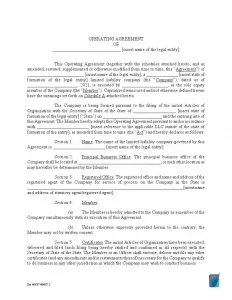Free LLC Operating Agreement Template
A Limited Liability Company (LLC) operating agreement is a vital legal document that establishes the relationships between company members while outlining their rights, obligations, powers, and liabilities. It also sets forth the internal policies and rules governing the business.
As the name implies, an LLC provides limited liability to its members, protecting their personal assets from the company’s debts and obligations.
The LLC operating agreement is as crucial as the articles of organization — the legal document that officially establishes the formation of the company. This article covers everything you need to know about what should be included in an operating agreement and the important factors to consider when creating one.

Build Your Document
Answer a few simple questions to make your document in minutes
Save and Print
Save progress and finish on any device, download and print anytime
Sign and Use
Your valid, lawyer-approved document is ready
- Alabama
- Alaska
- Arizona
- Arkansas
- California
- Colorado
- Connecticut
- Delaware
- Florida
- Georgia
- Hawaii
- Idaho
- Illinois
- Indiana
- Iowa
- Kansas
- Kentucky
- Louisiana
- Maine
- Maryland
- Massachusetts
- Michigan
- Minnesota
- Mississippi
- Missouri
- Montana
- Nebraska
- Nevada
- New Hampshire
- New Jersey
- New Mexico
- New York
- North Carolina
- North Dakota
- Ohio
- Oklahoma
- Oregon
- Pennsylvania
- Rhode Island
- South Carolina
- South Dakota
- Tennessee
- Texas
- Utah
- Vermont
- Virginia
- Washington
- West Virginia
- Wisconsin
- Wyoming
Single-Member vs. Multi-Member Operating Agreements
Depending on the number of members involved, an LLC can either be a single-member or a multi-member entity. While LLC operating agreements for both types serve the same purpose, their structures differ slightly. Let’s explore the distinctions between these two types of operating agreements.
Single-member LLC operating agreement
The primary objective of a single-member LLC operating agreement is to reinforce the company’s status as a separate business entity distinct from the owner’s personal assets. This document should outline the owner’s role in the LLC and the responsibilities of other positions, such as registered agents and managers. Although not required to be filed with any government agency, the operating agreement should be kept in the owner’s records at the principal place of business.
While notarization is not a formal requirement for a single-member LLC operating agreement, it is highly recommended to sign the document before a notary to verify its authenticity and the exact date of signing.
Multi-member LLC operating agreement
Designed for LLCs with multiple owners, this type of operating agreement is crucial for specifying ownership percentages and other details about the company. The agreement should be signed in the presence of a notary, and copies should be distributed to all members. The original must be stored at the company’s principal office address.
In a multi-member LLC operating agreement, there should be information about:
- LLC management
- Procedures for buying and selling members’ interests (in cases of sale, disability, or death)
- Ownership percentages for each member
- Rights and obligations of the owners
- Voting powers of each member
- Methods for allocating profits and losses
- Meeting procedures
Now, let’s delve deeper into each provision within an LLC operating agreement.
What Should an LLC Operating Agreement Include?
An operating agreement is a cornerstone of every LLC. It is a comprehensive document that contains essential information about the owners, their powers, responsibilities, and more. Including all important details in the operating agreement protects an LLC’s status, ensuring it does not resemble a sole proprietorship or partnership, which could compromise its members’ limited liability.
Every LLC operating agreement should include the following provisions.
Formation of the LLC
This provision should specify the date of the agreement, its location, the company’s formation date, its formal name, and the registered office of the business entity. It should also include the business purpose, the duration of the operating agreement, and whether the LLC is single-member or multi-member.
Equity structures
This section encompasses the following clauses:
- Membership Interest: Clearly define each member’s economic and management interests.
- Classes of Membership Interests: Specify the different types of interests your LLC will have, which may include non-voting, common, profits, and other types of interests.
- Members’ Contributions and Membership Accounts: Detail the forms of members’ contributions, such as cash, property, promissory notes, obligations, or a combination of various forms. Also, include information on whether initial capital contributions will be followed by any additional contributions.
- Allocation of Profits and Losses: Explain how profits and losses will be allocated among members. This can be proportionate by default, or members may be granted unique economic rights.
Internal management
This section should cover the following aspects:
- Management Authority: Specify who has the power to manage the LLC, whether it’s the members or appointed managers.
- Managers’ Names and Number: If managers are chosen, include their names and the number of managers serving in the LLC.
- Powers and Compensation: State the powers granted to the managers and whether they will receive any compensation for their services.
- Manager Appointment Procedure: Outline the process for appointing managers.
- Manager Meetings: Specify when and how manager meetings can be held and what actions are permissible without organizing a meeting.
- Manager Removal and Replacement: Include details on how managers can be removed or replaced within the LLC.
Voting procedure
While the default rule for voting rights in an LLC is in proportion to a member’s percentage interest, the operating agreement can modify this rule. Consider the following elements in the voting procedure section:
- Alternative Voting Rules: Specify any alternative rules for voting that deviate from the default proportionate voting method.
- Veto Rights: If applicable, allocate veto rights to specific members or managers, giving them the power to block certain decisions.
- Supermajority Votes: Outline any situations that require supermajority votes, where decisions must be approved by a larger-than-usual majority of members or managers.
Limitation of liability and indemnification
In this section of the LLC operating agreement address the following aspects related to liability and indemnification:
- Situations for Holding Members and Managers Harmless: Clearly define the circumstances in which members and managers should be held harmless, protecting them from personal liability for the LLC’s actions.
- Company Indemnification: Specify when the company will indemnify members and managers, providing them with financial protection against any claims, losses, or damages arising from their roles within the LLC.
Books and Records
This section of the operating agreement addresses record keeping and members’ rights to inspect the LLC’s financial records. Consider including the following elements:
- Record-Keeping Requirements: Specify the types of records the LLC must maintain, such as financial statements, tax filings, and membership information.
- Location of Records: Indicate where the LLC’s records will be stored, typically at the principal place of business.
- Rights to Inspect Records: Outline the rights of members to inspect and obtain copies of corporate and accounting records, as well as any restrictions or conditions that may apply.
Member meetings
Outline the guidelines for member meetings, including the following aspects:
- Frequency of Meetings: State that members are generally required to hold meetings at least once a year.
- Regular and Special Meetings: Specify when regular meetings should be held and under what circumstances special meetings may be called.
- Events Leading to Meetings: Describe the events or situations that can trigger the need to organize a meeting.
- Written Notice: Indicate when and how written notice should be sent to members prior to meetings.
- Quorum: Define what constitutes a quorum or the minimum number of members required to hold a meeting.
- Decision-Making Requirements: Specify the required number of members needed to make decisions during meetings.
- Voting Rights: Clarify which members are entitled to vote and any related conditions or restrictions.
Membership interests and admission
In this part of the LLC operating agreement address the following aspects related to membership interests and the admission of new members:
- Buying and Selling Rights: Outline the permissible methods for buying and selling membership interests among existing and new members.
- Right of First Refusal: Describe the right of first refusal, which gives existing members the privilege to purchase a departing member’s interest before it is offered to an outside party (applicable to multi-member LLCs).
- Membership Transfers: State whether membership interest transfers are permissible and under what conditions.
- Admission of New Members: Detail the procedure for admitting new members to the LLC.
- Members’ Consent: Specify the required form of consent for members when making decisions related to membership interests and admissions, such as written, electronic, or unanimous consent.
Withdrawal events
This section of the operating agreement should address the impact of withdrawal events, such as a member’s death or disability, on the LLC and its operations:
- LLC Continuation: Specify if the LLC will continue its operations in case a member passes away or becomes disabled, along with any procedures necessary to ensure the company’s ongoing activities.
- LLC Termination: Describe the circumstances and processes for dissolving the LLC in the event of a member’s death or disability, including asset distribution and the winding-up process.
Dissolution and termination of the company’s operation
In this section, address the following aspects related to the dissolution and termination of the LLC:
- Causes for Dissolution: Specify the actions or events that would trigger the dissolution of the LLC, such as member withdrawal, bankruptcy, or legal requirements.
- Asset Distribution: Detail how the assets of the LLC should be distributed among members upon dissolution, taking into consideration any outstanding liabilities and debts.
- Capital Account Withdrawals: State whether members are allowed to withdraw funds from their capital accounts during the dissolution process and under what conditions.
- Winding-Up Process: Describe the procedures and timeline for winding up the LLC’s affairs, including the payment of debts, distribution of remaining assets, and any necessary filings or notifications to relevant authorities.
Amendments
Here, address the procedures and requirements for making amendments to the agreement:
- Consent Requirement: State that any changes or modifications to the LLC operating agreement must receive the written consent of either all members or a majority of the members, as specified by your company’s preferences.
- Amendment Process: Describe the process for proposing, discussing, and approving amendments to the LLC operating agreement, including any required notice period or meeting procedures.
Miscellaneous provisions
In this section of the LLC operating agreement, include any additional terms or clauses that have not been addressed in the previous sections:
- Governing Law: Specify the state law governing the interpretation, enforcement, and resolution of disputes related to the LLC operating agreement.
- Severability: Include a clause stating that if any provision of the operating agreement is deemed unenforceable or invalid, the remaining provisions will still be in effect.
- Entire Agreement: State that the operating agreement represents the entire agreement between the members regarding the LLC and supersedes any prior agreements or understandings.
- Headings: Note that the headings used throughout the operating agreement are for convenience and reference only and do not affect the interpretation of the agreement’s terms.
- Binding Effect: Mention that the operating agreement is binding upon and inures to the benefit of the members and their respective heirs, executors, administrators, successors, and assigns.
How to Set Up an LLC?
Setting up an LLC can be straightforward if you carefully follow the necessary steps and pay close attention to each stage.
1. Choose the state of incorporation

Some states, such as Florida, Wyoming, Texas, Nevada, and Delaware, are known for their favorable tax laws, making them potentially more attractive for establishing a business. The location may not be as crucial for online businesses, allowing for easy registration in any state. However, for local, brick-and-mortar businesses serving a specific community, it is generally advisable to register the entity within the state of its operation.
If you plan to set up your LLC in a different state from your residence, you will need the assistance of a registered agent (RA) who is a resident of the state where you intend to establish your company. Registered agents are often available through professional services.
2. Select the name of your business entity

Selecting an appropriate name for your company is crucial, as it influences customers’ perception of your business. The name should be catchy and concise while reflecting your business’s niche. It must also include the words “Limited Liability Company,” “LLC,” or another state-approved abbreviation.
Keep in mind that your company name cannot duplicate existing names. With the vast number of companies in every state, some creativity may be required to find a unique name.
For example, a name like “[State] [Niche of business] LLC” is likely to be already taken, which can be verified using the respective Secretary of State’s office website. For instance, to check existing business names in California, use the database of business entities provided on the California Secretary of State website.
Pay attention to the entity’s status – if it is dissolved, the name can be used, but not if the entity has an “active” status.
Many online systems allow you to reserve your preferred name for a certain amount of time before filing the articles of incorporation. By paying a small fee, you can secure the chosen name for a period ranging from 30 to 120 days, depending on the state.
In today’s digital age, having a website is essential for businesses. Therefore, it’s important to consider your website’s name before registering your LLC name. To ensure consistency, try finding an available domain first and then choose a similar name for your LLC.
3. Select an agent for your business

When forming an LLC, it’s important to select a registered agent who will be responsible for receiving legal notices on behalf of the business. Your registered agent must be listed in both the articles of organization and the LLC operating agreement.
You can choose to appoint a member of your LLC or a third party as your registered agent. Keep in mind that another business entity can also serve as your agent, but an individual must sign the articles of organization on behalf of the entity.
In a single-member LLC, you may act as your own registered agent if it’s allowed by your state. However, it’s worth considering the potential drawbacks of acting as your own agent, such as loss of privacy and the need to maintain a physical mailing address in the state of incorporation.
It’s important to note that your registered agent must have a physical address in the state where your LLC is incorporated, as PO boxes are not acceptable. This ensures that legal notices can be properly delivered and processed in a timely manner.
4. Determine the ownership

When forming an LLC, it’s important to determine the company’s ownership structure. Ownership shares, known as units, are issued to members and represent their percentage of ownership interest in the LLC. For example, if an LLC issues 100 units and one member owns 50 units, they have a 50% ownership interest in the company. This percentage may change if new members are added to the LLC.
Ownership interest includes both an economic interest, which determines how much profit a member receives, and a management interest, which determines the amount of voting power a member has in the company.
There is no limit to the number of members an LLC can have, and state laws allow for the creation of single-member LLCs. However, it’s generally recommended to keep the number of individual members small.
In addition to selecting the ownership structure, it’s important to choose an authorized representative who has the authority to act on behalf of the LLC. This could include tasks such as opening a bank account for the company.
It’s important to determine the LLC ownership structure before filing the articles of organization to ensure that each individual member’s ownership percentages and roles are clearly defined from the start.
5. File the articles of organization

After determining the ownership structure and selecting a registered agent, the next step in forming an LLC is to file the articles of organization. The process for filing may vary depending on the state where the LLC is being formed and can typically be done by mail or online through the local Secretary of State’s office.
When completing the articles of organization, it’s important to include the following information:
- The LLC’s place of business and mailing address (which can be the same)
- The name and physical address of the registered agent
- An email address for correspondence with the LLC
- The names of all LLC members and authorized representatives
6. Pay the filing fee

When filing the articles of organization, you will also need to pay a filing fee to register your LLC. This fee can vary by state and can range from $50 to $800. Payment can typically be made online or by check.
Once the Secretary of State’s office receives your payment, the registration process will begin. This process can take up to 30 days, after which your LLC will be considered active and legally recognized as a separate entity.
Be sure to review your state’s specific filing fees and payment options before submitting your articles of organization to avoid any delays or complications in the registration process.
7. Get an Employer Identification Number

Obtaining an Employer Identification Number (EIN) is a crucial step in forming an LLC, as it’s required for opening bank accounts and making tax payments. It’s important not to delay this step, as your LLC will be unable to conduct business transactions and generate profits until an EIN is obtained.
Fortunately, obtaining an EIN is a simple process that can be completed online through the IRS website or by submitting a specific application form by mail. The process typically takes no more than 15 minutes.
By obtaining an EIN, you’ll be able to legally conduct business and ensure that your LLC is properly recognized by the IRS. Be sure to obtain an EIN soon after forming your LLC to avoid any delays in your business operations.
8. Create an operating agreement

Once your LLC has been registered and is active, it’s important to create an operating agreement. While this document is not required to be filed with any government agency, it is an important internal document to keep for your own records. The operating agreement is also the only document outlining the LLC’s ownership percentage.
Creating an operating agreement requires careful attention and revision to ensure that all necessary provisions are included to protect the members of the LLC from personal liability.
Our online document builder can help you simplify the process of creating a legally binding LLC operating agreement that includes all necessary information and enable you to create a customized document in less than 15 minutes.
You can also just use the LLC operating agreement template we provide in PDF format free of charge if it suits your needs.

Sample Operating Agreement
LIMITED LIABILITY COMPANY OPERATING AGREEMENT
OF
[Company Name, LLC]
A [State] Limited Liability Company
THIS LIMITED LIABILITY COMPANY OPERATING AGREEMENT (the “Agreement”) is made and entered into as of [Date], by and among the undersigned members (each, a “Member” and collectively, the “Members”) of [Company Name, LLC], a [State] limited liability company (the “Company”).
ARTICLE I – FORMATION
1.1 Formation. The Members have formed a limited liability company under the laws of the State of [State] by filing the Articles of Organization with the [State] Secretary of State on [Filing Date].
1.2 Name. The name of the Company shall be [Company Name, LLC].
1.3 Purpose. The purpose of the Company is to engage in any lawful act or activity for which a limited liability company may be formed under the laws of the State of [State].
1.4 Principal Place of Business. The principal place of business of the Company shall be located at [Address, City, State, Zip Code]. The Company may change its principal place of business at any time upon written notice to the Members.
ARTICLE II – MEMBERSHIP
2.1 Members. The names and addresses of the Members, and their respective membership interests, are as follows:
Name: [Member 1] Address: [Address 1] Membership Interest: [Percentage 1]%
Name: [Member 2] Address: [Address 2] Membership Interest: [Percentage 2]%
2.2 Capital Contributions. Each Member shall contribute to the Company the amount of capital specified opposite such Member’s name in Section 2.1, in cash or property, as agreed upon by the Members.
2.3 Additional Contributions. No Member shall be required to make any additional capital contributions to the Company without the unanimous consent of the Members.
ARTICLE III – MANAGEMENT
3.1 Management. The management of the Company shall be vested in its Members. Each Member shall have authority to bind the Company in the ordinary course of its business.
3.2 Voting. Each Member shall have voting rights proportionate to its membership interest as set forth in Section 2.1. Except as otherwise provided in this Agreement, any action or decision of the Company shall require the affirmative vote of Members holding a majority of the membership interests.
ARTICLE IV – ALLOCATIONS AND DISTRIBUTIONS
4.1 Profits and Losses. The Company’s profits and losses shall be allocated among the Members in proportion to their respective membership interests, as set forth in Section 2.1.
4.2 Distributions. Distributions of the Company’s available cash, if any, shall be made to the Members at such times and in such amounts as determined by the Members, in proportion to their respective membership interests.
ARTICLE V – TRANSFERS AND WITHDRAWALS
5.1 Restrictions on Transfers. No Member may transfer, assign, or encumber any part of its membership interest in the Company without the prior written consent of all other Members.
5.2 Withdrawal of Member. A Member may withdraw from the Company only with the written consent of all other Members and upon payment to the withdrawing Member of the fair market value of its membership interest, as determined by the Members.
ARTICLE VI – DISSOLUTION AND WINDING UP
6.1 Dissolution. The Company shall be dissolved and its affairs wound up upon the earliest to occur of the following events: (a) the written consent of all Members to dissolve the Company; (b) the sale or other disposition of all or substantially all of the Company’s assets; (c) the occurrence of an event that causes the last remaining Member to cease to be a Member, unless the business of the Company is continued by the unanimous consent of the legal representatives of all Members; or (d) any other event causing dissolution under the laws of the State of [State].
6.2 Winding Up. Upon dissolution of the Company, the Members shall wind up the affairs of the Company in accordance with applicable law. The assets of the Company shall be applied and distributed in the following order: (a) payment of the Company’s debts and liabilities to creditors, other than Members; (b) payment of any debts and liabilities owed to Members, other than for distributions; (c) distribution of any remaining assets to the Members in proportion to their respective membership interests.
ARTICLE VII – INDEMNIFICATION
7.1 Indemnification. The Company shall indemnify and hold harmless each Member from and against any and all claims, liabilities, damages, losses, and expenses (including reasonable attorney’s fees) arising out of or in connection with the Member’s actions on behalf of the Company, provided that such actions were taken in good faith and in a manner the Member reasonably believed to be in, or not opposed to, the best interests of the Company.
ARTICLE VIII – AMENDMENTS
8.1 Amendments. This Agreement may be amended or restated only by the written consent of all Members.
ARTICLE IX – MISCELLANEOUS
9.1 Notices. All notices, consents, or other communications required or permitted under this Agreement shall be in writing and shall be deemed to have been duly given when delivered personally or sent by certified mail, return receipt requested, postage prepaid, to the Member’s address set forth in Section 2.1.
9.2 Governing Law. This Agreement shall be governed by and construed in accordance with the laws of the State of [State], without regard to its conflicts of law principles.
9.3 Binding Effect. This Agreement shall be binding upon and inure to the benefit of the Members and their respective heirs, executors, administrators, legal representatives, successors, and assigns.
9.4 Entire Agreement. This Agreement constitutes the entire agreement among the Members with respect to the subject matter hereof and supersedes all prior agreements, understandings, and negotiations, both written and oral, among the Members relating to the subject matter hereof.
IN WITNESS WHEREOF, the undersigned Members have executed and delivered this Agreement as of the date first above written.
Name: [Member 1]
Membership Interest: [Percentage 1]%
Name: [Member 2]
Membership Interest: [Percentage 2]%
LLC vs. Sole Proprietorship
If you plan to be your business’s sole owner, you may be wondering how a single-member LLC differs from a sole proprietorship. While both business structures offer flexibility and simplicity, there are important differences to consider when deciding which one is right for you.
Responsibility
In an LLC, owners are not personally liable for the company’s debts and liabilities. However, in a sole proprietorship, there is no separation between personal and business liability, and the owner is responsible for all business debts. Creditors can even use the owner’s personal assets, such as their home or car, to pay off business debts.
Bank accounts
Another key difference is that in a sole proprietorship, owners can use personal and business accounts interchangeably, while LLC owners are required to keep business funds separate from personal funds.
Business name
When forming an LLC, the business name must be registered with the state and include the fully written type of business structure or its abbreviation. There is no such requirement for sole proprietorships, but if the owner wants to operate under a name other than their own, they must register for a DBA (doing business as) name in their home state.
Taxation
Both LLCs and sole proprietorships face pass-through taxation, meaning that profits are taxed only once. Both business structures must submit a Profit or Loss from the Business form to the appropriate agency. However, LLCs have more flexibility in how they pay taxes and can choose to be taxed as a corporation or sole proprietorship, while sole proprietorships only have one option for taxation.
To ensure that your LLC’s operating agreement includes all necessary provisions and is attorney-verified, it’s recommended to use a professional document builder. Our document builder can help you create a customized operating agreement that includes all the information discussed in this article, saving you time and ensuring that you don’t miss any important details. The added benefit of using our service is that the operating agreement is easy to download and print, allowing you to quickly and easily access the document when needed.
